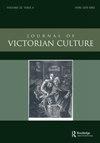A New Woman Dialogue with Aestheticism and Decadence: Netta Syrett’s Short Stories for The Yellow Book
IF 0.5
3区 历史学
Q2 HISTORY
引用次数: 0
Abstract
Focusing on critically neglected works by prolific writer Netta Syrett (1865–1943), this article reveals her New Woman dialogue with aestheticism and decadence in her early short stories written for the iconic 1890s periodical The Yellow Book: primarily, ‘A Correspondence’ (1895) and ‘Far Above Rubies’ (1897). Together they trace Syrett’s increasingly assertive voice and navigation of the period’s seemingly competing but intersecting aesthetic, decadent and feminist movements. I argue that Syrett uses aesthetic and decadent discourses as strategic vehicles for the articulation of the evolving feminist ideas more fully expressed in her later pro-suffrage works. Specifically, her stories register her response to the male elitism and misogyny of aestheticism and decadence through a critical engagement with their tropes (exotic setting; aestheticized interior; femme fatale) and discourses (of mythology; statuary; floriography) in order to challenge the objectification and marginalization of women by masculinist culture using its own terms of reference. Syrett’s stories are thus discursive spaces through which she articulates anxieties about women’s place in, or exclusion from, aestheticism and decadence, asserting her role in these movements as both participant and critic. This article thus offers a more comprehensive understanding of the evolving discourses of, as well as the dialogues and debates enacted by, fin-de-siècle women’s writing, shedding new light on the aesthetic and decadent movements.新女性与唯美主义和颓废派的对话:内塔-西莱特为《黄皮书》撰写的短篇小说
这篇文章关注多产作家内塔-西瑞特(Netta Syrett,1865-1943 年)被严重忽视的作品,揭示了她在为 19 世纪 90 年代标志性期刊《黄皮书》撰写的早期短篇小说中与唯美主义和颓废主义进行的新女性对话:主要是《一封信》(1895 年)和《远在红宝石之上》(1897 年)。这两篇小说共同追溯了西莱特在这一时期看似相互竞争却又相互交错的美学、颓废和女权运动中日益自信的声音和导航。我认为,西莱特将美学和颓废话语作为战略载体,在她后来支持选举权的作品中更充分地表达了不断发展的女权主义思想。具体而言,她的故事通过对唯美主义和颓废主义的套路(异国情调的环境、唯美化的内部装饰、致命的女性)和话语(神话、雕像、花卉)的批判性参与,对唯美主义和颓废主义中的男性精英主义和厌女症做出了回应,从而利用男性主义文化自身的参照系来挑战其对女性的物化和边缘化。因此,西莱特的故事是她的话语空间,她通过这些故事表达了对女性在唯美主义和颓废主义中的地位或被排斥在外的焦虑,并宣称自己在这些运动中既是参与者又是批评者。因此,这篇文章为我们提供了一个更加全面的视角,使我们能够理解二十世纪末期女性写作中不断演变的话语以及对话和辩论,从而为审美和颓废运动带来新的启示。
本文章由计算机程序翻译,如有差异,请以英文原文为准。
求助全文
约1分钟内获得全文
求助全文

 求助内容:
求助内容: 应助结果提醒方式:
应助结果提醒方式:


